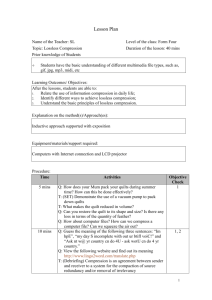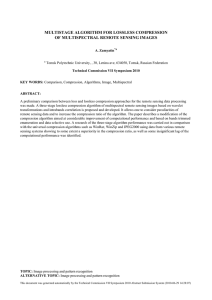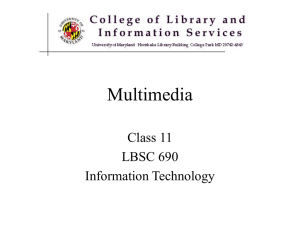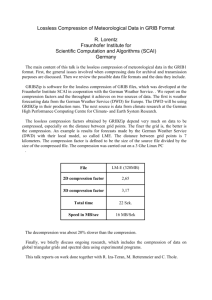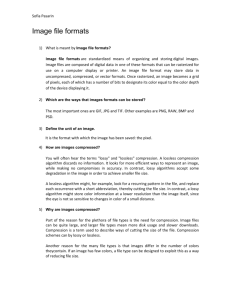International Journal of Application or Innovation in Engineering & Management (IJAIEM) Web Site: www.ijaiem.org Email: Volume 3, Issue 7, July 2014
advertisement
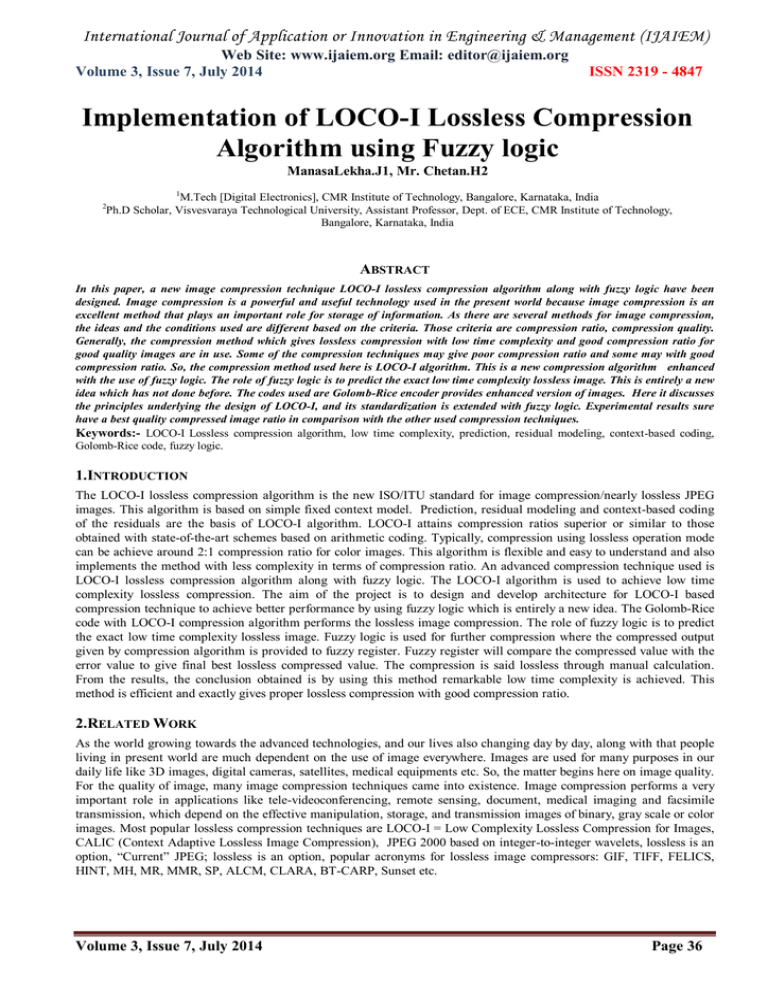
International Journal of Application or Innovation in Engineering & Management (IJAIEM) Web Site: www.ijaiem.org Email: editor@ijaiem.org Volume 3, Issue 7, July 2014 ISSN 2319 - 4847 Implementation of LOCO-I Lossless Compression Algorithm using Fuzzy logic ManasaLekha.J1, Mr. Chetan.H2 1 M.Tech [Digital Electronics], CMR Institute of Technology, Bangalore, Karnataka, India Ph.D Scholar, Visvesvaraya Technological University, Assistant Professor, Dept. of ECE, CMR Institute of Technology, Bangalore, Karnataka, India 2 ABSTRACT In this paper, a new image compression technique LOCO-I lossless compression algorithm along with fuzzy logic have been designed. Image compression is a powerful and useful technology used in the present world because image compression is an excellent method that plays an important role for storage of information. As there are several methods for image compression, the ideas and the conditions used are different based on the criteria. Those criteria are compression ratio, compression quality. Generally, the compression method which gives lossless compression with low time complexity and good compression ratio for good quality images are in use. Some of the compression techniques may give poor compression ratio and some may with good compression ratio. So, the compression method used here is LOCO-I algorithm. This is a new compression algorithm enhanced with the use of fuzzy logic. The role of fuzzy logic is to predict the exact low time complexity lossless image. This is entirely a new idea which has not done before. The codes used are Golomb-Rice encoder provides enhanced version of images. Here it discusses the principles underlying the design of LOCO-I, and its standardization is extended with fuzzy logic. Experimental results sure have a best quality compressed image ratio in comparison with the other used compression techniques. Keywords:- LOCO-I Lossless compression algorithm, low time complexity, prediction, residual modeling, context-based coding, Golomb-Rice code, fuzzy logic. 1.INTRODUCTION The LOCO-I lossless compression algorithm is the new ISO/ITU standard for image compression/nearly lossless JPEG images. This algorithm is based on simple fixed context model. Prediction, residual modeling and context-based coding of the residuals are the basis of LOCO-I algorithm. LOCO-I attains compression ratios superior or similar to those obtained with state-of-the-art schemes based on arithmetic coding. Typically, compression using lossless operation mode can be achieve around 2:1 compression ratio for color images. This algorithm is flexible and easy to understand and also implements the method with less complexity in terms of compression ratio. An advanced compression technique used is LOCO-I lossless compression algorithm along with fuzzy logic. The LOCO-I algorithm is used to achieve low time complexity lossless compression. The aim of the project is to design and develop architecture for LOCO-I based compression technique to achieve better performance by using fuzzy logic which is entirely a new idea. The Golomb-Rice code with LOCO-I compression algorithm performs the lossless image compression. The role of fuzzy logic is to predict the exact low time complexity lossless image. Fuzzy logic is used for further compression where the compressed output given by compression algorithm is provided to fuzzy register. Fuzzy register will compare the compressed value with the error value to give final best lossless compressed value. The compression is said lossless through manual calculation. From the results, the conclusion obtained is by using this method remarkable low time complexity is achieved. This method is efficient and exactly gives proper lossless compression with good compression ratio. 2.RELATED WORK As the world growing towards the advanced technologies, and our lives also changing day by day, along with that people living in present world are much dependent on the use of image everywhere. Images are used for many purposes in our daily life like 3D images, digital cameras, satellites, medical equipments etc. So, the matter begins here on image quality. For the quality of image, many image compression techniques came into existence. Image compression performs a very important role in applications like tele-videoconferencing, remote sensing, document, medical imaging and facsimile transmission, which depend on the effective manipulation, storage, and transmission images of binary, gray scale or color images. Most popular lossless compression techniques are LOCO-I = Low Complexity Lossless Compression for Images, CALIC (Context Adaptive Lossless Image Compression), JPEG 2000 based on integer-to-integer wavelets, lossless is an option, “Current” JPEG; lossless is an option, popular acronyms for lossless image compressors: GIF, TIFF, FELICS, HINT, MH, MR, MMR, SP, ALCM, CLARA, BT-CARP, Sunset etc. Volume 3, Issue 7, July 2014 Page 36 International Journal of Application or Innovation in Engineering & Management (IJAIEM) Web Site: www.ijaiem.org Email: editor@ijaiem.org Volume 3, Issue 7, July 2014 ISSN 2319 - 4847 2.1Motivation for LOCO-I Lossless Compression Algorithm:- Implementation of LOCO-I lossless compression algorithm using fuzzy logic is entirely a new idea. LOCO-I compression algorithm is an excellent method which attains low time complexity of image compressed along with good quality compared to other methods. This algorithm is flexible and easy to understand also implements the method with less complexity in terms of compression ratio. There are lots of image compression techniques that are in widespread use today. Use of LOCO-I compression algorithm using fuzzy logic for image compression is better than conventional methods. There are widely used methods for image compression and decompression. So, one of the efficient method used here is LOCO-I compression method. Because LOCO-I itself says that low time complexity lossless compression for images with better quality can be obtained. This algorithm is extended with fuzzy logic which is entirely a new idea which becomes best method for image compression. There will be always considerable amount of loss during compression or decompression while using other methods than using LOCO-I method. But still may find some small amount of loss when compression takes place which has to overcome is the main drawback. 3.LOCO-I LOSSLESS COMPRESSION ALGORITHM LOCO-I (Low Complexity Lossless Compression for Images) is a lossless compression algorithm for continuous-tone images which combines the simplicity of the algorithm is based on a simple context model, which has the capability of more complex universal context modeling techniques for capturing high-order dependencies. The model is tuned for effective performance along with Golomb-Rice code. To say truly, LOCO-I is being considered by the ISO committee as a replacement for the current lossless standard in low-complexity applications. Lossless data compression schemes often consist of two distinct and independent components: modeling and coding. The modeling part can be equated as an inductive inference problem, in which the data (e.g., an image) is observed sample by sample in some pre-defined order. The conceptual separation between the modeling and coding operations was made possible by the invention of the arithmetic codes. These two milestones in the development of lossless data compression allowed researchers to view the problem merely as one of probability assignment, concentrating on the design of imaginative models for specific applications (e.g., image compression) with the goal of improving on compression ratios. Context-based modeling has become a popular technique in image compression algorithms. The concept of context was first used in text compression where in the context of a symbol was defined as the N symbols preceding it. During the modeling stage of text compression, the model assigns a probability to a symbol based not only on the frequency of occurrence of this symbol but also on the frequency counts of this symbol’s context. In the coding stage, the symbols are coded on their probabilities conditioned on their contexts. Figure 3.1 A casual template for LOCO-I [1] The prediction and modeling units in LOCO-I are based on the casual template x denotes the current pixel and a, b, c, d and e are neighboring pixels in the relative positions. The FPGA LOCO-I algorithm takes input as a rectangular image with 8-bit pixel values (the pixel values are lies in the range 0 to 255). The compressed image constructed is a sequence of bits from which the original image can be reconstructed. The FPGA LOCO-I algorithm is based on predictive compression. While compressing the pixels in the image, processing is done in raster scan order. For all other pixels of the image, the processing that occurs can be divided into four steps: Divide the pixel into one of several contexts according to the values of previously encoded pixels. The pixel value is estimated from previously encoded pixels and add a correction (Called the bias), which depends on the context. Tabulate the difference between the estimated and the actual pixel value to a nonnegative integer and encode this integer using Golomb’s variable length codes. Update the statistics and improvements for the context based on the new pixel value. 3.1Performance Measurement of LOCO-I Lossless Image Compression:- The performance of a lossless image compression algorithm can be specified in terms of compression efficiency and complexity. Compression efficiency is measured by the compression ratio or by the bit rate. Compression ratio is the size of the original image to the size of the compressed image and bit rate is the number of bits per pixel required by the compressed image. For example, a 256*256*8bits=65536*8bits=65,536 bytes when stored in uncompressed form, if the compressed images requires 32768 bytes, then the compression ratio is 65536/32768=2.0. Since the image has 256*256=65,536 pixels, the compressed file needs 32768*8/65536=4 bits per pixel, on average. Hence the bit rate is 4.The compression ratio and bit rate are related. Let ‘b’ be the numbers of bits per pixel of the uncompressed image, ‘CR’ the compression ratio, and ‘B’ the bit rate. The following equality is readily obtained CR = b/ BR. Volume 3, Issue 7, July 2014 Page 37 International Journal of Application or Innovation in Engineering & Management (IJAIEM) Web Site: www.ijaiem.org Email: editor@ijaiem.org Volume 3, Issue 7, July 2014 ISSN 2319 - 4847 Figure 4.1 A PSI-1, k Rice Encoder [3] PSI-1 code is optimal for a monotonically decreasing distribution source with a first-order entropy around 2, i.e., 1.5<H<2.5. For H>2.5, it is safe to assume that the least significant bits (LSBs) of sample data di(j) are completely different. In this case there is no need to perform any compression on those LSBs. An encoder can then split di(j) into two portions: k LSBs and (8-k) most significant bits (MSBs), as shown in figure 4.1. The MSBs are coded using PSI-1 encoder before being sent to bit stream, while the LSBs are sent decoded. A decoder must first recover the MSBs using PSI-1 decoder, and then concatenates the results with decoded SBs, resulting in the desired di(j). 4.FUZZY LOGIC IMPLEMENTATION Figure 5.1 Fuzzy Logic Implementation The compressed value obtained by Rice coder is given to Fuzzy logic unit. The compressed value is the input given to fuzzy registers to store the compressed values accordingly obtained. Then these compressed values are given to demultiplexer with 3 bit selector. Again the demultiplexed outputs are given to fuzzy comparator which compares each value with the last error value to show the fine lossless compressed output. 4.1Manual Calculation to show Compression is Lossless:- Consider an example of 8-bit data 00011101. Split 8-bit data into 4-bit MSB and 4-bit LSB like 1101=MSB and 0001=LSB. The MSB does not change. The LSB in the reverse order like 1000 count in the reverse order and it will become 8. By padding 8 zeros and putting 1-bit at the end in front of MSB like 1000000001101. By considering 8 zeros as 1 zero along with 1-bit it will become 101101. This is called as compressed bit. Again split into MSB and LSB like 1101=MSB and 10=LSB. Take LSB in the reverse order it will become 01 and consider it as 0001 and by padding these bits again in front of MSB it will become 00011101. This is the original 8-bit data before compression and is lossless. 5.RESULT The Simulation results of designs implemented using Verilog Hardware Description Language on Xilinx ISE. Simulation results are obtained for lossless image compression using Modelsim which are shown below in the figure 6.1 respectively. Figure 6.1 Simulation result of LOCO-I Lossless image compression Volume 3, Issue 7, July 2014 Page 38 International Journal of Application or Innovation in Engineering & Management (IJAIEM) Web Site: www.ijaiem.org Email: editor@ijaiem.org Volume 3, Issue 7, July 2014 ISSN 2319 - 4847 The input is 8-bit data. By activating the pins chip select as 1 and enable as 1, the 1-bit compression takes place as shown in figure 6.1 waveform which will become 7-bit data. The compression is lossless are referred through manual calculation. Table 6.1 Device Utilization Summary Table 6.2 Timing Summary Table 6.1 shows the device utilization summary of the design where we have a efficient utilization with less number of LUTs and slices being utilized and Table 6.2 shows the timing summary where operating frequency is about 204.809MHz and minimum period is 4.883ns. 6.CONCLUSION Here LOCO-I lossless compression algorithm along with fuzzy logic unit is designed and implemented. LOCO-I lossless compression algorithm has two distinct and independent components: modeling and coding. The modeling part can be equated as an inductive inference problem in an image is observed sample by sample in some pre-defined order. In the coding stage, the symbols are coded on their probabilities conditioned on their contexts. Depending on this behavior of LOCO-I can able to obtain lossless image compression with low time complexity and good compression ratio. The coding part contains Golomb-Rice coder. Finally, fuzzy logic unit is designed to predict appropriate low time complexity lossless output which achieves good compression ratio. Hence it discusses the principles underlying the design of LOCO-I, and its standardization is extended with fuzzy logic. From the results can conclude that using this method can remarkably make the low time complexity. REFERENCES [1] LOCO-I: A Low Complexity, Context Based Lossless Image Compression Algorithm Marcelo J. Weinberger, Gadiel Seroussi, and Guillermo Sapiro Hewlett-Packard Laboratories, Palo Alto, CA 94304 [2] An FPGA Implementation of a Simple Lossless Data Compression Coprocessor Armein Z. R. Langi#*+1 *ITB Research Center on Information and Communication Technology #DSP-RTG, Information Technology Research Division School of Electrical Engineering and Informatics+ITB MicrolectronicCenter InstitutTeknologi Bandung, JalanGaneca 10 Bandung, Indonesia 40132 1langi@dsp.itb.ac.id [3] ITU-T. ISO DIS 10918-1 Digital compression and coding of continuous-tone still images (JPEG). Recommendation T.81 [4] M. J. Weinerberger, G. Seroussi, and G. Sairo, “LOCO-I: A Low Complexity, context-based, lossless Image Compression Algorithm”,proc. Of the 1996 Data Compression Conference (DCC ’96), snowbird, Utah, pp.141-149, March 1996. [5] Information Technology-Lossless and Near-Lossless compression of continous-Tone still Images, ISO/IEC 14495-1, ITU Recommendation T.87, 1999. [6] M. J. Weinberger, G. Seroussi, and G. Sapiro, “The LOCO-I Lossless Image Compression Algorithm: Principles and Standardization into JPEG-LS,” IEEE Transactions on Image Processing, vol. 9, pp. 1324, August 2000. Volume 3, Issue 7, July 2014 Page 39 International Journal of Application or Innovation in Engineering & Management (IJAIEM) Web Site: www.ijaiem.org Email: editor@ijaiem.org Volume 3, Issue 7, July 2014 ISSN 2319 - 4847 [7] Low-complexity near-lossless image compression method and its application-specific integrated circuit design for a wireless endoscopy capsule system Xiaowen Li ; Xiang Xie Guolin Li ; Li Zhang ; Zhihua Wang [+] Author Affiliations J. Electron. Imaging. 16(1), 013015 (March 09, 2007). doi:10.1117/1.2711802 AUTHORS Ms. ManasaLekha.J is currently pursuing her M.Tech in Digital Electronics in CMR Institute of Technology and she is in the final semester of her course. Her interests lie in image processing, LOCO-I lossless image compression, Fuzzy logic. She continues her research in these areas. She had pursued the B.E degree in Electronics and Communication Engineering from Channabasaveshwara Institute of Technology in the year 2012. Mr. Chetan.H is currently working in CMR Institute of Technology as an Assistant Professor in the Department of Electronics and Communication. He had pursued the B.E degree in Electronics and communication from SJBIT and M.Tech in VLSI and Embedded Systems from BIT. His interest lies in the field of image processing and VLSI. Currently he is doing his research work in image processing under Visvesvaraya Technological University. Volume 3, Issue 7, July 2014 Page 40
